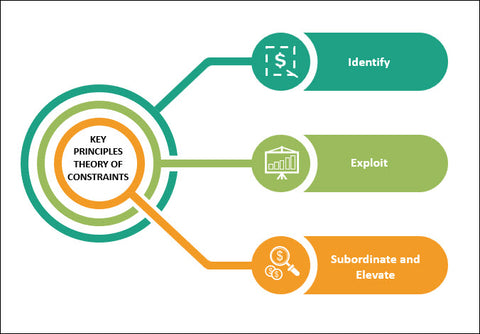Theory Of Constraints
Introduction
The Theory of Constraints (TOC) is a management philosophy and methodology developed by Dr. Eliyahu M. Goldratt. It provides a framework for identifying and improving the constraints that limit the performance of a system, with the goal of maximizing overall throughput and profitability. TOC challenges traditional management practices and focuses on achieving global optimization rather than local optimization.

Understanding The Fundamentals Of Theory Of Constraints
The Theory of Constraints is based on several fundamental principles:- Every system has at least one constraint, which limits its ability to achieve higher performance.
- The performance of a system is determined by its weakest link or constraint.
- Identifying and exploiting the constraint is essential for improving system performance.
- To optimize overall system performance, the entire organization should align its efforts towards supporting the constraint.
The Key Principles Of Theory Of Constraints
The Theory of Constraints is guided by three key principles:
- Identify: Identify the constraint(s) that limit the system's performance. This can be a physical constraint, such as a bottleneck in production, or a policy constraint, such as outdated rules or procedures.
- Exploit: Exploit the constraint by maximizing its utilization and efficiency. Focus resources and efforts on ensuring the constraint operates at its maximum capacity.
- Subordinate And Elevate: Subordinate non-constraints to the constraint and elevate the constraint's performance. Coordinate activities, processes, and resources in a way that supports and optimizes the constraint, while ensuring non-constraints do not interfere with the constraint's operation.
Applying Theory Of Constraints For Business Success
TOC can be applied in various areas of a business, such as operations, supply chain management, project management, and decision-making. By identifying and addressing constraints, businesses can achieve significant improvements in throughput, cycle time, lead time, and overall system performance. TOC encourages a focus on the core goal of generating profit and helps businesses make better decisions by considering the impact on the constraint and overall system performance.
Overcoming Roadblocks With Theory Of Constraints
TOC provides strategies for overcoming roadblocks and common challenges, such as variability, uncertainty, and conflicting priorities. It emphasizes the importance of buffer management, exploiting capacity constraints, and establishing clear policies and measurements to guide decision-making. TOC also encourages organizations to continuously identify and address new constraints as they emerge.
When implementing the Theory of Constraints (TOC), you may encounter roadblocks or challenges along the way. Here are some strategies to overcome common roadblocks and ensure successful implementation of TOC:
- Resistance To Change: Resistance to change is a common roadblock in any organizational transformation. To overcome this, it is important to communicate the benefits of TOC and involve employees in the process. Provide clear explanations of how TOC will improve performance and address any concerns or misconceptions. Encourage open dialogue, address resistance proactively, and demonstrate the value of TOC through early wins and success stories.
- Lack Of Awareness Or Understanding: Lack of awareness or understanding about TOC can hinder implementation efforts. Conduct training sessions and workshops to educate employees at all levels about TOC principles and concepts. Ensure that everyone understands the purpose and potential benefits of TOC, as well as their roles and responsibilities in the implementation process.
- Limited Resources: Implementing TOC may require allocating resources, such as time, budget, and personnel. If there are limitations in resource availability, prioritize the areas or processes where constraints have the most significant impact on overall performance. Optimize resource utilization by focusing efforts on exploiting and elevating the identified constraints to maximize throughput and profitability.
- Lack Of Data And Measurement Systems: Accurate and reliable data is essential for effective TOC implementation. Ensure that appropriate data collection systems and measurement tools are in place to monitor key performance indicators (KPIs) related to constraints, throughput, cycle time, and other relevant metrics. If necessary, invest in technology or systems to facilitate data collection, analysis, and reporting.
- Complex Or Interconnected Processes: Some organizations have complex processes or interconnected systems, making it challenging to identify and manage constraints. Break down the processes into manageable segments and focus on the critical points where constraints are most likely to occur. Apply TOC principles to each segment, ensuring alignment and coordination between different parts of the system to optimize overall performance.
- Lack Of Cross-Functional Collaboration: Successful TOC implementation requires collaboration and cooperation across different departments or functions within the organization. Break down silos and encourage cross-functional teams to work together towards the common goal of constraint management. Foster a culture of collaboration, open communication, and shared responsibility for system optimization.
- External Factors And Uncertainties: External factors, such as market conditions or regulatory changes, can create uncertainties that impact TOC implementation. Anticipate and plan for potential disruptions or changes in the external environment. Develop contingency plans and build flexibility into your TOC strategies to adapt to unforeseen circumstances while still maintaining focus on constraint management and system performance.
- Continuous Improvement: TOC is an ongoing process of improvement and adaptation. Embrace a mindset of continuous improvement and learning. Regularly review and evaluate the effectiveness of TOC implementation, identify areas for refinement, and make necessary adjustments to your strategies, processes, or resource allocation.
By addressing these roadblocks proactively and applying strategies tailored to your organization's specific context, you can overcome challenges and ensure a successful implementation of TOC. Regularly monitor progress, celebrate achievements, and foster a culture of continuous improvement to sustain the benefits of TOC over the long term.
Implementing Theory Of Constraints In Your Organization
Implementing the Theory of Constraints (TOC) in your organization involves a systematic approach to identify and address constraints that limit performance. Here are some steps to consider when implementing TOC:- Gain Management Support: Obtain support from top-level management to ensure commitment and resources for implementing TOC. Explain the benefits and potential improvements that TOC can bring to the organization.
- Identify The Constraint: Identify the key constraint(s) within your organization. This can be a physical constraint, such as a bottleneck in a production process, or a policy constraint, such as outdated rules or procedures that hinder efficiency.
- Exploit The Constraint: Focus on maximizing the utilization and efficiency of the identified constraint. Allocate resources and adjust processes to ensure the constraint operates at its maximum capacity.
- Subordinate And Elevate: Coordinate non-constraints to support and optimize the performance of the constraint. Align policies, procedures, and resources in a way that minimizes interference with the constraint's operation. Elevate the constraint's performance by removing any barriers or limitations.
- Develop Buffer Management: Implement buffer management to manage variability and uncertainties within the system. Identify and establish buffers at critical points in the process to protect the constraint from disruptions and to maintain overall system flow.
- Continuously Improve: Continuously monitor and measure system performance. Establish key performance indicators (KPIs) to track the impact of constraint management on throughput, cycle time, lead time, and other relevant metrics. Regularly review performance data and adjust strategies as needed.
- Employee Training And Engagement: Provide training and education to employees on TOC principles and techniques. Foster a culture of continuous improvement and encourage employee engagement by involving them in identifying and addressing constraints.
- Communication And Collaboration: Establish clear communication channels and promote collaboration among different departments or teams. Encourage open dialogue to share insights, challenges, and solutions related to constraint management.
- Review And Adjust: Conduct periodic reviews to assess the effectiveness of TOC implementation. Analyze the results, identify any new constraints that may have emerged, and make necessary adjustments to strategies or processes.
- Continual Application: TOC is an ongoing process that requires continual application and improvement. Embed TOC principles into your organization's decision-making processes, project management practices, and strategic planning to achieve long-term success.
Remember that successful implementation of TOC requires commitment, patience, and a willingness to challenge existing assumptions and practices. It is essential to involve all relevant stakeholders and to adapt TOC principles to the specific needs and characteristics of your organization.
Common Mistakes when Implementing the Theory of Constraints
Some Common Mistakes When Implementing TOC Include:
- Focusing solely on local optimizations rather than overall system performance.
- Neglecting to address non-constraints that may hinder the performance of the constraint.
- Underestimating the importance of cultural change and employee engagement.
- Overlooking the need for ongoing measurement and adjustment of strategies.
Conclusion And Future Of The Theory of Constraints :
The Theory of Constraints offers a powerful framework for improving system performance and achieving business success. By identifying and optimizing constraints, organizations can enhance their competitiveness, customer satisfaction, and profitability. The future of TOC lies in its continued application across various industries and the integration of emerging technologies, such as artificial intelligence and data analytics, to support constraint identification and decision-making processes.




